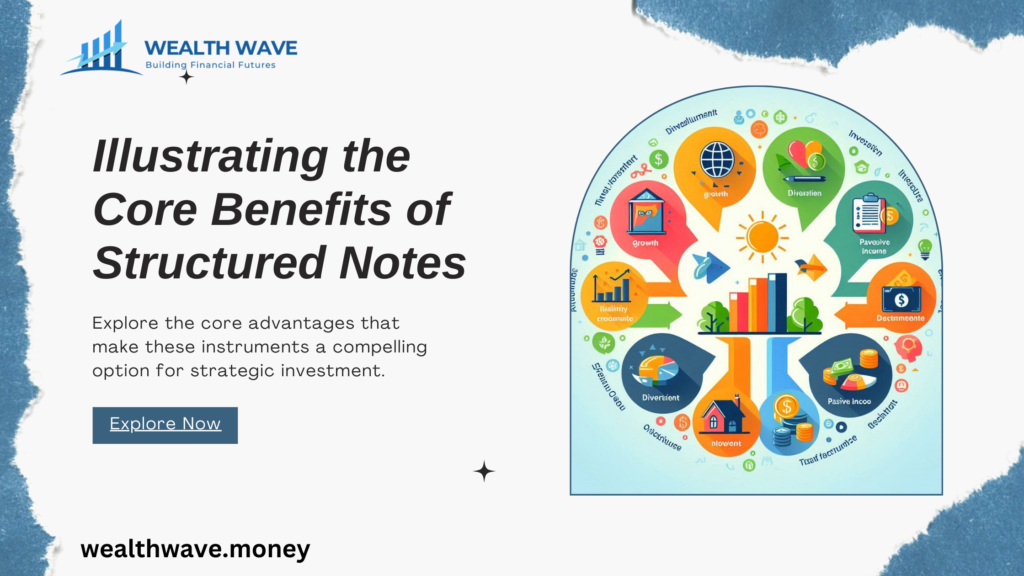Are you feeling a tad restless with the usual stock, bond, and mutual fund lineup? It’s as if these options don’t quite capture what we’re really looking for. Well, you’re not alone in this quest for something more customized.
Our journey led us to structured notes—a nifty blend of bonds and derivatives that pave the way for individualized payouts aligned with your financial dreams.
What makes structured notes appealing? There’s a real allure in not settling for off-the-rack investment opportunities; instead, having something crafted just for you. Structured notes stand out because they offer that sought-after control over returns and risks, allowing an investor-friendly approach to diversifying portfolios or hedging against uncertainty—all without getting tangled up in complexity.
Intrigued? Stick around as we unwrap how stepping into structured notes could beautifully rework your approach to investing!
Key Takeaways
- Structured notes blend bonds and derivatives, creating custom payouts that match individual financial goals. They offer control over returns and risks, fitting unique investor needs.
- Custom structured notes allow for personalization in investment strategies. You can choose payout structures based on your risk tolerance, aim for diverse market exposure, or seek enhanced returns through a mix of assets like stocks, ETFs, and commodities.
- Key benefits include tailoring to specific investment goals, accessing various parts of the market without direct investment in stocks or mutual funds, and opportunities for higher yields compared to traditional fixed-income investments.
- Tools like SIMInON and Halo help manage structured note investments by simplifying pricing information and portfolio management. This efficiency supports better growth opportunities.
Exploring Structured Notes
Moving on from our introduction, we explore structured notes. These financial instruments blend debt obligations with an embedded derivative component, making them unique. Imagine combining loans issued by banks with the exciting assets like stocks or interest rates.
This mix offers investors a way to potentially gain higher returns while having some level of protection against losses.
Structured notes are not one-size-fits-all; in fact, about 85-90% are custom-made to fit specific investor needs and goals. With a global presence surpassing $3 trillion in assets, these investment vehicles have found a significant footing in the U.S., attracting both individual and institutional investors seeking customized investment solutions.
They offer diverse market exposure and can be customized to pay out based on various scenarios tied to the performance of their underlying asset classes such as equity indexes or fixed income securities—making them an appealing choice for those looking to diversify their portfolios beyond traditional stocks and bonds.
Key Benefits of Structured Notes in Personal Investment Strategies
Custom structured notes offer personalized investment strategies tailored to individual preferences and risk tolerance. They provide diverse market exposure, opportunities for enhanced returns, and efficient investment management.
Tailoring Payout Structures
We can make payout structures fit what you want from your investment. This means we match your goals with how you get money back. If protecting your money is key, we focus on structured products that limit loss if markets drop.
For those wanting regular income, we pick investments that pay out often. And if it’s growth you’re after, we find options that let you gain when the market rises.
These payouts depend on different things like stock indexes or commodities. So whether you’re into the S&P 500 or fascinated by foreign currencies, there’s something for everyone. We combine these underlying assets in a way that aims to meet your financial targets while keeping an eye on safety and growth opportunities.
Options for Diverse Market Exposure
Structured notes give us a unique way to reach many parts of the market. We can link them to single stocks, broad indexes, or even different types of assets. This means we get more ways to spread our investments around.
For example, if we want exposure to technology companies or international markets without buying individual stocks or using mutual funds, structured notes can be an ideal choice.
We also use exchange-traded funds (ETFs) and commodities futures within structured notes for broader market access. These options let us tap into areas like precious metals or energy sectors indirectly, enhancing the diversity of our portfolio.
After exploring diverse market exposure opportunities, turning our focus to achieving boosted returns becomes natural.
Opportunities for Enhanced Returns
After discussing how structured notes offer diverse market exposure, we see another advantage: they can bring higher yields. Structured notes often outperform traditional fixed-income investments like corporate bonds or U.S. Treasury bonds in certain situations.
This advantage comes from their unique design, combining derivatives with other investment products to aim for better outcomes.
These custom instruments provide payoffs that are hard to match elsewhere, allowing investors to profit from various market conditions while keeping losses in check. Whether markets go up or down, certain structured notes are designed to capitalize on these movements, offering gains that might not be possible with more conventional investments.
With careful planning and a clear understanding of the potential risks and rewards, we use structured notes as part of our strategy for chasing higher returns without losing sight of our overall investment goals.
Efficiency in Investment Management
Custom structured notes help us save a lot of time. They do this by giving us portfolios that are both diverse and hedged, without the need for us to build each one from scratch. This means we can manage our investments more efficiently, focusing on what matters most.
This way, managing money becomes less of a chore and more of an opportunity for growth.
Popular Varieties of Structured Notes in Investment Portfolios
Popular varieties of structured notes in investment portfolios encompass principal-protected notes, barrier notes, and customized structured products. They provide opportunities for investors to tailor their investments towards specific goals and risk tolerance levels.
Fundamentals of Principal-Protected Notes
Principal-Protected Notes (PPN) keep your initial investment safe from market downturns. These notes are great for those of us who want to avoid risk. They mix a bond that pays no interest until it matures with options that can tailor the outcome of our investments.
This means even if the stock market dips, we don’t lose our principal amount.
These products come from mixing debt securities and derivative instruments like options contracts. This blending allows us to aim for higher returns while keeping our invested capital secure against loss.
Next, let’s explore how Barrier Notes work and their role in personalizing our investment strategies further.
Overview of Barrier Notes
Barrier notes are a type of structured product that come with built-in protection against price declines. They do this through buffers, which help to shield investors from some market downturns.
These financial instruments can be a smart choice for those who are risk-averse yet looking for capital gains opportunities in volatile markets. With barrier notes, investors get to enjoy the potential upside of market movements without bearing the full brunt of downside risks.
Digital notes form another category under barrier notes and offer a unique payout structure. They typically pay out one coupon payment at maturity, making them attractive for income-focused strategies.
This approach allows investors to aim for specific investment outcomes based on their personal goals and market views.
With barrier and digital notes, we’re equipped to tackle uncertain markets head-on.
Now, let’s explore insights into customized structured products.
Insights into Customized Structured Products
Moving from the basic principles of barrier notes, we step into the customized structured products. These offer investors a chance to shape their investment tools to meet specific goals.
Choosing options for diverse market exposure or personalizing payout structures becomes straightforward. Whether it’s income notes for steady earnings or growth notes aiming at higher returns, customization is key.
This ability ensures we can adjust our portfolio based on market sentiments or individual risk tolerance, making investment management more efficient and personal.
Considerations and Risks Associated with Structured Notes
Considering risks linked with structured notes is crucial for making informed investment choices. Understanding credit risk, liquidity challenges, pricing complexities, and call risks in the context of structured notes is vital.
Navigating Credit Risk
We all need to pay close attention to credit risk with structured notes. This is because not every note protects the principal amount you invest. Credit risk happens if the issuer, like an investment bank, can’t meet its financial promises.
These issuers create structured notes for savvy investors such as hedge funds and big institutional investors.
To manage this risk, we look at the issuer’s health before investing. We consider their credit ratings and past performance on similar products. If an issuer defaults, investors might lose some or all of their investment, even without principal protection.
So, it’s key to know who is issuing your structured note and understand their financial stability.
Challenges of Limited Liquidity
Structured notes present challenges in limited liquidity, as they are not widely traded. This lack of liquidity means that selling them on the secondary market may be difficult, impacting the ability to adjust investment positions swiftly.
Buffer exchange-traded funds (ETFs) offer more liquid alternatives compared to structured notes.
The limited liquidity of structured notes underscores the importance of carefully considering the impact on portfolio management and adjusting investment strategies accordingly.
Understanding Pricing Complexities
Pricing in structured notes relies on the day’s observed price, potentially resulting in missed payouts. This rigidity often leads to overpriced notes due to issuer costs, affecting potential returns for investors.
These complexities make pricing a crucial consideration when incorporating structured notes into investment strategies.
Moving forward to “Awareness of Call Risks” we see that anticipating call risks is essential for managing structured note investments effectively and maximizing potential returns.
Awareness of Call Risks
Understanding call risks is crucial when considering structured notes. Some of these investment products come with a call option, allowing the issuer to redeem the note before maturity, impacting potential returns and creating reinvestment challenges.
This means that even if conditions are favorable for investors, such as interest rates rising or improved market performance, issuers can exercise their call rights – potentially affecting the anticipated benefits.
Therefore, it’s essential to carefully evaluate these risks before incorporating structured notes into investment strategies.
By being aware of call risks tied to some structured notes, we can better assess potential impacts on our investment portfolios and make informed decisions when crafting personalized strategies.
The Role of Structured Notes in Diversifying Portfolios
Structured notes play a crucial role in broadening investment portfolios, offering a unique approach to managing risks and returns. They enable investors to blend traditional investments with derivative strategies, thereby diversifying exposure across various asset classes and market conditions.
By tailoring payout structures and incorporating downside protection features, these instruments provide an avenue for enhancing portfolio resilience in the face of volatility and uncertainty.
Moreover, structured notes offer opportunities for customizing exposure to diverse underlyings such as equities, fixed income securities, or alternative assets. This adaptability allows investors to fine-tune their risk-return profiles according to their specific investment objectives and market views.
As a result, structured notes have emerged as versatile tools for optimizing portfolio performance while mitigating potential risks inherent in traditional investing approaches.
Key Concepts: Structured Notes, Investment Portfolios, Traditional Investments,
Derivative Strategies
Real-World Applications: Structured Notes in Action
Structured notes in action are prevalent in the realm of alternative investments. One significant player, Yieldstreet, has set an ambitious target to generate $3 billion of income outside traditional public markets by 2025.
This platform currently offers access to 10 alternative asset classes and has a track record across more than 470 investments. These impressive figures underline the increasing significance and demand for structured notes as part of diversified investment strategies.
In real-world applications, underliers such as municipal bonds, index ETFs, and zero-coupon bonds are meticulously harnessed within custom structured products to enhance returns and manage risks effectively.
The evolving landscape also signifies that market timing is crucial when deploying absolute notes or barrier notes to navigate volatile market values better. Therefore, instead of being daunting complexities, these instruments are becoming bespoke tools enabling investors to unlock opportunities beyond conventional market offerings.
Tailor your investment options
Custom structured notes offer diverse investment opportunities with potential for good returns. These practical strategies are efficient and provide tailored payouts, catering to different risk appetites and market conditions.
Emphasizing the importance of diversifying portfolios through structured notes can lead to significant improvements in investment outcomes. Exploring this avenue further offers an array of possibilities for investors seeking enhanced returns and downside protection.
We encourage you to consider these tips in your investment journey, as they can shape a more robust financial future.
FAQs
1. What are custom structured notes?
Custom structured notes are a type of debt security that banks issue. They let us choose how our investment grows by linking our returns to different market indexes or assets. This way, we can have customized payouts that match our personal investment goals.
2. How can these notes help diversify my portfolio?
By investing in custom structured notes, we’re adding a unique element to our portfolios. These notes can be tied to various assets like stocks, bonds, or foreign exchange markets. This variety helps us spread out our investment risk and potentially stabilize returns even when the market is volatile.
3. Are there risks involved with custom structured notes?
Yes, like all investments, these notes come with their own set of risks including market risk and the chance that the issuer might not be able to pay back the note at maturity. It’s important for us to review each note’s terms and understand the level of risk before investing.
4. How do taxes work with these types of investments?
The taxation on custom structured notes depends on their structure and how they payout. Generally, if a note matures at more than its purchase price or pays out interest, those earnings may be taxed as income or capital gains under U.S securities regulations overseen by entities like the SEC (Securities and Exchange Commission) and FINRA (Financial Industry Regulatory Authority).
5.What should I look for in an investment adviser when considering custom structured notes?
When looking for an adviser about investing in custom structured heritages , it’s wise to seek someone registered with regulatory bodies such as the SEC or FINRA who has experience dealing with complex products like convertible heritagesfutures contracts ,and options strategies . They should offer clear advice tailored to your financial situation.
6.How do I know if these investments are right for me?
Considering whether custom organized papers fit into your strategy involves understanding your tolerance for volatility , desired rate of return ,and how long you plan to invest . Speaking with a qualified finance professional can provide clarity here; they’ll analyze factors like durationissuance rates,and potential tax implications against your goals.




